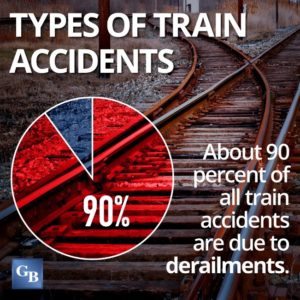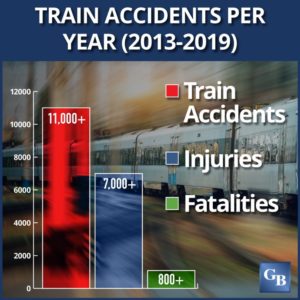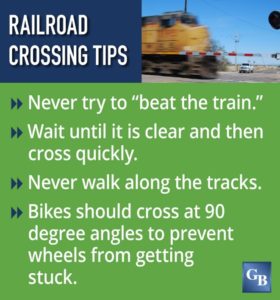By law railroads are required to provide a safe mode of transportation for passengers and tons of freight. Still, thousands of train accidents occur in the United States each year, causing hundreds of deaths and many more injuries. Passenger trains, commuter trains, subways, light-rail systems, freight trains, and cargo trains all have the potential to cause serious or fatal injuries in the event of an accident.
Individuals injured in train accidents have the right to seek recovery of damages to pay for medical expenses, loss of income, and pain and suffering. However, the process of determining who is liable for damages resulting from a train accident is complex, requiring a skilled and experienced legal team. Those who have been injured in a train accident should contact the Philadelphia train accident lawyers at Galfand Berger LLP. We have been assisting injured individuals for more than 75 years. Our legal team has successfully obtained justice for individuals and their families who have been injured because of train accidents.

What are the Most Common Types of Train Accidents?
The most common types of train accidents include the following:
- Derailments
- Railroad crossing accidents involving train and vehicle collisions
- Pedestrian accidents
- Work accidents
- Electrical shock caused by high voltage electrical lines
- Falling from railcars that lack required safety appliances
Train accidents can happen in a variety of ways. Victims may include passengers, crew members, pedestrians, or people in other vehicles. Many railroad accidents occur at work where workers load and unload railcars or ride on railcars as part of their job requirements.
The Federal Railroad Administration (FRA) is responsible for investigating significant train accidents. The agency dispatches field personnel to the scene of serious train accidents to determine their cause and decide whether a formal investigation is warranted.
How Common are Derailments?
Derailments are the most common type of train accidents in the United States. According to the FRA, more than 1,100 derailments happened in 2020 alone. A study published by the University of Illinois found that most derailments are caused by problems with the railroad track, equipment failure, or human error. Although most derailments do not result in injuries, those that do can have devastating consequences:
- In May 2015, an Amtrak train derailed near the Kensington section of Philadelphia, killing eight people and injuring more than 200. The cause of the derailment was determined to be high speed, or operator error.
- In Paulsboro, New Jersey, a cargo train derailed in 2012, releasing toxic vinyl chloride gas. More than half of the residents of Paulsboro reported harmful effects after the incident.
One primary cause of derailments is weakened railroad ties, which allows the rail pairs to spread too far apart. Another less common but more serious risk of derailment is track buckling due to hot weather. Because it is difficult to predict exactly when rails might buckle from the heat, train operators will often slow down the speed of the train as a preventative measure when there is a heat wave. Track buckling may be a growing problem in the future because of the increasing prevalence of heat waves attributed to climate change.
How Many Pedestrians Are Involved in Fatal Train Accidents?
Pedestrian accidents involving trains account for the highest percentage of train accident fatalities per year, according to the U.S. Department of Transportation. These types of accidents are often referred to as trespasser fatalities. Sadly, New Jersey has one of the highest rates of pedestrian fatalities from train accidents in the United States, with 14 deaths recorded in 2020. There were 13 pedestrian fatalities in train incidents in Pennsylvania during that same year.
Although some pedestrians who are hit by trains may have intended to end their own lives, most were just walking along the train tracks, unaware of the danger.
Between 2015 and 2019, the number of incidents involving pedestrians hit by trains at crossings in the United States jumped 25 percent. Less than one-fifth of these fatalities were ruled suicide.
The actual number of pedestrians killed on train tracks may be higher, as the FRA does not require most subways or light-rail transport systems to report fatalities. Many of these transport systems use the same railroad tracks as other types of trains.
How Deadly are Railroad Crossing Accidents?
According to the U.S. Department of Transportation (DOT), deaths in highway-rail grade crossing accidents are the second-leading category of fatalities from train accidents. Fortunately, train and vehicle collisions at railroad crossings are not frequent as they were 30 years ago. Still, at least 200 to 300 people lose their lives in fatal railroad crossing incidents each year in the United States. In Pennsylvania, there were 54 collisions at railroad crossings in 2020, resulting in five fatalities.
Unlike train derailments, which are due to equipment malfunctions or train operator error, the majority of railroad crossing accidents are due to error on the part of car drivers. In many incidents, drivers are attempting to beat the train so they do not have to wait at the crossing.
Although comparatively rare, train and vehicle collisions are deadly because of several factors, including the following:
- If a train operator sees a car on the tracks, it may take up to a mile before the train can come to a complete stop.
- When a car collides with a train, the fatality rate is more than 30 times higher than if the car collides with another vehicle.
It is fairly rare for a car to stall out on a railroad crossing. It is more likely that the driver just does not want to wait for the train to pass and tries to jump in front of the train quickly and gets stuck over bumpy tracks. The wisest course is to just wait until the train passes before crossing.
Work Accidents Involving Trains
Although work accidents involving trains do not get a lot of publicity, workers continue to suffer injury and death when working on or around rail cars. According to the Railroad Workers United, dozens of workers are killed on the job each year in accidents that could have been prevented.
Some examples of rail worker fatalities that occurred during 2019 and 2020 include the following:
- A 53-year-old employee in Indiana was killed when another railcar rolled over her when she fell from a train car that was backing up.
- A PATCO worker was killed in Lindenwold, New Jersey, at the transit line’s train yard.
- An MTA motorman from Brooklyn, New York, was killed in a subway fire that was ruled as arson.
- A SEPTA railroad worker was fatally struck by a commuter train on the Broad Street Line in Philadelphia while inspecting the track and making minor repairs.

Unfortunately, railroad and subway operators do not always alter their safety policies after these types of tragedies. Workers who are injured on the job and family survivors of workers killed on the job should seek the advice of a qualified lawyer to help them navigate the process of seeking recovery for damages after a tragic workplace accident.
How Do Power Line or Third Rail Accidents Happen?
Power line or third rail accidents happen when a person is electrocuted by coming in contact with a train’s high voltage power lines. Many trains that traverse Pennsylvania and New Jersey, including the regional trains operated by SEPTA, use electrical power transmitted from overhead wires. The electricity is transferred from these wires to a device mounted on the top of each train. Amtrak also uses a similar system along the Northeast Corridor route. Power lines also run down along the railroad tracks; collectively, these power lines are often referred to as the third rail.
Railroad yards housing trains and train signal towers are supposed to be locked and off limits to the public. However, third rail accidents still occur where children and teenagers are able to enter railyards and other dangerous areas from ungated access points near the tracks. Tempted to climb trains or train signal towers, children have been electrocuted in third rail accidents when they come in contact with power lines on tracks or above the trains.
Premises owners may be liable for injuries to children who are injured in this way even if the child was trespassing on their property. Pennsylvania courts consider structures that attract children yet pose significant risks to them as attractive nuisances. Premises owners are responsible for ensuring that children cannot get near these dangerous structures. In some cases, children have been able to access high voltage lines because the railroad company failed to secure access points and properly maintain fencing along its railroad tracks.
Why Do I Need a Lawyer if I am Injured in a Train Accident?
Individuals who are injured in a train accident need a lawyer to help determine who may be liable to pay for damages. Determining liability in a train accident is a complicated process. An experienced and competent lawyer will assemble a team to investigate the circumstances surrounding the incident. This includes scrutinizing the design, operation, and maintenance of railroad tracks as well as the train itself. The investigation will also examine the actions of the crew leading up to and during the accident.
To obtain recovery of damages, a plaintiff needs to prove that the accident was caused by someone else’s negligence. For example, a railroad operator may be found negligent if the railroad tracks or equipment were not regularly inspected. Next, a plaintiff must be able to show that the accident caused injury, and there were material damages arising from that injury. These damages may include but are not limited to medical expenses, loss of income, and pain and suffering. Knowledge of the specific laws governing train safety are important in determining negligence.
What Laws Regulate Train Safety?
The Federal Railroad Administration (FRA), an agency of the U.S. Department of Transportation (DOT), is responsible for carrying out the federal railroad safety laws. The FRA has the authority to issue and enforce safety regulations on intercity freight and passenger rail service used by millions of Americans each year. The FRA requires railroads to file detailed reports of all significant train accidents or incidents.
One of the most important laws regulating train safety is the Rail Safety Improvement Act of 2008. This act further promoted the use of positive train control technology across the United States to prevent derailments due to excessive speed and other types of train accidents. The act also regulates hours for railroad workers and other measures to reduce human error.
What is Positive Train Control?
Positive train control (PTC) uses computer systems, radio waves, and global positioning system (GPS) technology to continuously monitor a train’s position and automatically adjust its speed or operation if it is exceeding the speed limit. This is particularly important when trains are rounding a curve. PTC can also re-route a train to avoid derailment or an impending collision with another train.
Federal investigators determined that the deadly Amtrak accident in Philadelphia on May 12, 2015, could have been avoided if PTC technology had been implemented in the train.
How Many People are Hurt Each Year in Train Accidents?
Thousands of people are hurt each year in train accidents. In 2020, the decrease in railroad traffic due to the pandemic helped to drive down the number of injuries and deaths from train accidents. However, prior to the pandemic, the number of people injured or killed by trains was increasing. According to the National Safety Council, railroad deaths totaled 907 in 2019, an increase of more than 11 percent from the previous year. There were also nearly 8,000 nonfatal injuries in 2019. Fatalities at highway-rail crossings increased 14 percent from 2018 to 2019, whereas fatalities involving other types of incidents increased 10 percent. Most deaths were attributed to trespassers.
How Has Galfand Berger LLP Helped Injured Train Accident Victims?
Despite our laws and progress made over the years, train accidents continue to happen. Injured accident victims have the right to seek recovery of damages from parties deemed responsible for the accident. Galfand Berger LLP has helped injured train accident victims by thoroughly investigating the causes the accident, determining liability, calculating damages, and winning settlements for full recovery of damages. In some cases, damages pay for medical bills and lost wages. When a victim’s injuries are fatal, recovery settlements help widowed spouses and families compensate for lost future income, pain and suffering, and rebuild their lives after devastating and unexpected tragedies.
The following cases illustrate how Galfand Berger LLP has been able to help train accident victims in the past:
- Brakeman at steel mill killed in rail car accident. The worker was responsible for directing locomotives to stop and allow ground switches to be set. While performing his duties, he slipped and fell from a railcar, suffering a crushed skull and other injuries that proved fatal. Galfand Berger lawyers thoroughly investigated the accident and found that the railcar lacked federally mandated safety features, including grab bars, handholds, and foot stirrups. This occurred despite the fact that other railcars operated by the steel mill owner were equipped with basic safety features. Even more disturbing were the lawyers’ findings that the steel mill was not conducting quarterly inspections of its rail cars nor removing those from service that had damaged or missing safety equipment. The steel mill owner had also instructed employees to mount railcars while they were in motion. Rick Jurewicz and the Galfand Berger LLP legal team obtained a $3 million recovery for the family of the deceased brakeman.
- Worker fatally injured during loading and unloading operations. Rick Jurewicz and the Galfand Berger team were able to secure a $5 million settlement for the family of a worker who was fatally injured when an 1800-pound paper roll fell off a railcar that was delivering bulk paper rolls.

How can I Avoid Accidents at Railroad Crossings?
In situations in which accidents are caused by someone else’s negligence, there is often nothing that a victim could have possibly done to avoid harm. However, there are steps that car drivers or pedestrians can take to avoid accidents at railroad crossings, including the following:
- When approaching a railroad crossing, limit all distractions such as texting or talking.
- Never attempt to beat the train at a railroad crossing.
- Pedestrians should always cross quickly and never walk along the tracks.
- When riding a bike or pushing a stroller, cross at a 90-degree angle to prevent wheels from getting stuck.
Drivers and pedestrians should never underestimate a train’s speed, its inability to stop quickly, and its size, which is typically several feet wider than the width of a track.
Philadelphia Train Accident Lawyers at Galfand Berger LLP Fight for Injured Train Accident Victims
Trains typically provide safe and reliable transportation of goods and passengers, particularly in comparison with cars, buses, and trucks. However, when train accidents happen, the results can be serious or fatal. If you or a loved one has been injured in a train accident, contact the Philadelphia train accident lawyers at Galfand Berger LLP. We have an established record for successfully helping injured accident victims recover the damages for which they are entitled. We are always happy to answer any questions you may have about our investigative process. To schedule a free and confidential consultation, call us at 800-222-USWA (8792) or contact us online. From our offices in Philadelphia, Bethlehem, Lancaster, and Reading, Pennsylvania, we proudly serve clients throughout Pennsylvania and New Jersey, including Allentown and Harrisburg.
 Google Screened
Google Screened
